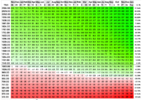NOT-ADVICE. LIKE REALLY.I agree, a lot of this comes down to risk appetite, and more importantly what is backing the puts. I prefer not to sell my core shares due to tax implications in my regular account, and my bps are mostly margin backed, with very wide room to roll / split / flip. You on the other hand are doing cash backed spreads and obviously it makes sense to be substantially more aggressive. I'd probably be doing something similar in your shoes.
This is an instance of why I don't use %OTM as a primary or particularly important criteria for selecting my strikes. A couple of weeks ago I was more worried about a 700/900 put spread than I am today about a 750/1050 put spread. What's different?
A couple or 3 weeks ago the quick run up turning into a quick run back to 900 didn't seem all that difficult to imagine. Today (for me) even dropping below 1000 seems very unlikely. So now I've got some put spreads that are slightly ITM (though those are on a roll, so they don't count - rolling positions for time will leave one in an abnormally aggressive position). But I've also got put spreads that are $66 OTM I'm comfortable with, where $200+ OTM spreads a couple of weeks ago were uncomfortable.
That's also a function of where I think support for the share price (for puts / put spreads) are at and how much support that I think will show up at each of those strikes. It's a function of the delta at those strikes, though I've been finding that I've been using delta less and less in my decision making. And it's a function of max pain, and more importantly the put and call walls. And of course what my gut tells me is going to happen.
%OTM is something that needs to be adjusted constantly based on the IV, news upcoming, and other stuff. All of this stuff combined probably doesn't prepare people for that sharp and fast rise to $1250, but its a starting point.
For risk management the combination of the wide spread that causes the short puts to behave like naked puts, at least within a fairly wide range ($75-$150 on these $300 wide spreads), also means that I've got a fair bit of leeway in how far ITM I can go and still roll effectively. The present instance - I rolled $1150 strike puts for this week expiration down to $1120 strikes and collected a $22ish premium for the privilege. I could have rolled down to $1100 for a lower premium - probably $5-7, but decided that my upward bias is strong enough to give myself a week and see.
And if the shares go back down, I'm confident that I can get a good roll even down at $1050. That good roll might only get me to $1100. If I'm particularly wrong and the shares are more like $1000 then the next roll might be for 2 weeks and will in either case be for a maximum strike improvement. The point is that I believe I've got a great backup / management choice on deck and ready to go, with more behind that (including a straight out roll for time and minimal net credit down to around $900 share price). Too much good news coming for a $900 share price to last long.
All of this stuff goes into the soup, at least for me, when deciding on the strike I want to open.
Related to this - I believe that my most profitable month or two was over the summer when the shares were in the low 700s and then up in the mid / upper 700s with low IV. We'd been in that range long enough that I was selling the 700 strike puts over and over, and then the 730s, even though not far OTM, collecting premiums that were yielding 7-10% on open. My target is 1-3%, so 7-10% was bonkers good.
In a lot of ways I wish we were still trading in that 730-790is range at low IV. My portfolio value would be a lot lower but the cash would be pouring in a lot faster. And I wouldn't be selling calls as the premiums were too low to justify being in front of a share price pop that could come any time
Right now I have a similar feeling about where we're at. Namely that we're reasonably close to a bottom of the range where the shares will trade. Acting on that belief - I'll be able to sell puts that are much closer to the money than I'd be selling if we wake up next week and the shares are $1250. I'll probably still be selling the 1050s at that point, or I might come up to 1100. I'll need to see that 1250+ share price for a few weeks before I think that's become a new low / support price.





